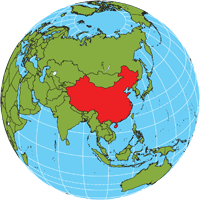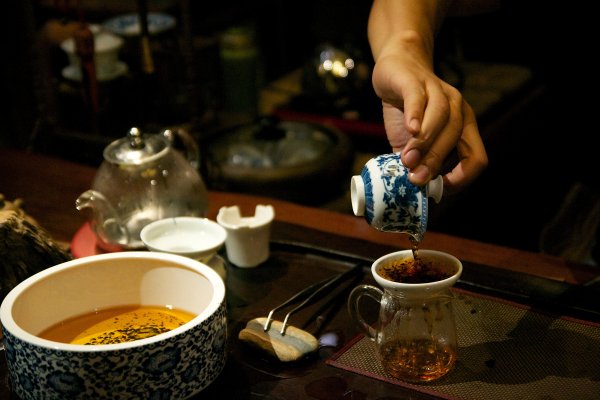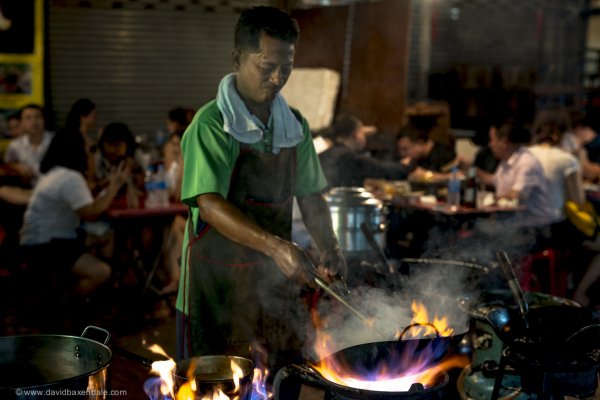Food and Drink: National Cuisine
Chinese cuisine is popular throughout the world, but its roots and varieties are more diverse and complex than one might think from sampling the standard dishes exported and modified for international palates. The traditional fare of the average Chinese person is very simple, with rice and noodles as staples augmented by small amounts of stir-fried meat and vegetables. In the North, wheat and millet are more prevalent, and noodles and steamed buns are more common. However, beyond this simple base, there is a staggering range of complex formal dishes and a seemingly infinite variety of snacks, soups, stir-fries, and main courses made from a wide range of meats, vegetables, and seasonings. Ingredients (vegetables, meat, tofu) are typically prepared in bite-sized pieces (cubes, strips, slices) because they cook faster that way and are easier to eat with chopsticks. Fish, however, is almost always served whole, with the head on. Soups (eaten with spoons) are very popular, and are traditionally served after a cold appetizer and a hot main course. The bowl of rice, served with the entrée in overseas restaurants, comes at the end of the meal in China.
The Taoist philosophical principle of balancing yin and yang (different but complementary elements) is fundamental to Chinese cuisine. Many dishes attempt to achieve this balance by combining different tastes (sweet, salty, bitter, and sour), colors, and textures (soft, crisp, chewy, raw) in just the right proportions. Presentation is extremely important for formal meals and vegetables are commonly carved into the shapes of flowers and animals.
Some rare ingredients like frog’s stomachs, snake’s gall bladders, and shark’s fins are attributed with medicinal or aphrodisiac benefits and held in high regard. Preserved foods like dried sausages, thousand-year-old eggs (preserved for 10 weeks), and dried seafood (fish, squid, shrimp, jellyfish) are another unique fixture of Chinese cooking.
Regional differences are pronounced and generally categorized under the "Eight Great Traditions" ("Ten Great Traditions" if you add Beijing and Shanghai styles): Anhui, Cantonese, Fujian, Hunan, Jiangsu, Shandong, Sichuan, and Zhejiang. Up north, stir-fried dishes like fried bean curd with minced meat and scallions, fried pork with shredded ginger, and fried lamb and onion are popular. Beijing is known for its succulent Peking Duck. In the Northwest, Mongolian "hotpot"-style dishes are common. In Sichuan, meals are extremely spicy, and smoked and pickled foods are popular. In Yunnan in the Southwest, pork dishes are a regional specialty. In Fujian, dried fish, mushrooms, and soy sauce are incorporated into many dishes. Buddhists and Muslims also have their own culinary styles within these regions and beyond them. Go far west, into the remote expanses of Xinjiang, and you'll find robust dishes of broth-cooked pulled noodles, salted vegetables, and fire-roasted herbed lamb.
Many types of vegetables are popular, including bok choy, pe-tsai (Chinese cabbage), water chestnuts, lotus root, bamboo shoots, scallions, and mustard greens. Fungi like shiitake mushrooms, straw mushrooms, tree ears, and oyster mushrooms are also prized. Spices in Chinese cooking include star anise, ginger, garlic, and five spice powder (anise, fennel, cinnamon, clove, and cayenne). Many sauces and condiments are also deployed, including soy sauce, oyster sauce, toasted sesame oil, and fermented black beans.
Beverages of choice in China include tea (green, ginseng, and black), rice wine, and liqueurs like mei kuei lu (rose dew) made from a sorghum base and flavored with rose petals and mao tai. Dairy products are not part of the Chinese diet. Although dessert is not a part of daily meals, fresh fruits like logan and lychee are popular for dessert, and small cakes made from bean paste are special treats.
A typical breakfast includes congee, a kind of rice gruel, often embellished with pickled vegetables or seasonings. Breakfast might also include noodles, dumplings, or steamed buns, depending on the region.
Copyright © 1993—2025 World Trade Press. All rights reserved.

 China
China 



